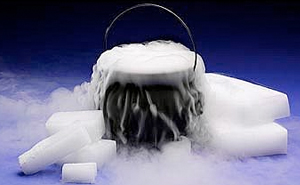 Dry Ice Production Identification – Carbon dioxide – Synonym Carbonic Anhydride Chemical Formula CO2 Chemical Family – inorganic
Dry Ice Production Identification – Carbon dioxide – Synonym Carbonic Anhydride Chemical Formula CO2 Chemical Family – inorganic
Dry Ice Temperature is -109.3 Fahrenheit which requires special handling and care – must wear glove at all times.
Dry ice makes Carbon Dioxide as it sublimates.
Dry ice is created by using extreme pressure that converts CO2 gas into a frozen solid then is processed and cut to specified units for use.
Storage of dry ice is as follows:
- Wrapped in a towel/cloth/paper and kept stored in a Styrofoam or other type cooler/container keep containers ventilated if using a plastic cooler, leave lid cracked open and or open the drain spicket. Do not place in working refrigerator or freezer.
Disposal of dry ice
- Sublimation takes place when the solid turns into vapor naturally. We suggest leaving any unused portion in a container and leave outside so that dissipation will occur into the atmosphere. As a precaution, we recommend staying in ventilated areas and again always use gloves for hand/skin protection. Any exposure to skin at -109 Fahrenheit will burn any exposed skin.
Dry Ice Shelf Life: With proper containment and coverage
5 – 7 Pounds 18 – 24 hours
8 – 12 Pounds 24 – 28 hours
13 – 20 Pounds 48 – 60 hours
Suggested Quantities for Common Uses:
| Use | Amount | Elapsed Time |
| Standard Cooler | 5-7 Pounds per Day | 18-24 hours |
| Beverages | 2 x 2 inch cubes – 1 per drink | (needs to sublimate) |
| Fun Effects – Fog | 5-10 Pounds (4–8 gallons hot water) | 30-45 minutes |
| Shipping | 5-7 Pounds | 2 Pounds of Perishables for 24 hours |
| Emergency/Power Outage | 10 Pounds per square foot of refrigerator space | 12 hours |
